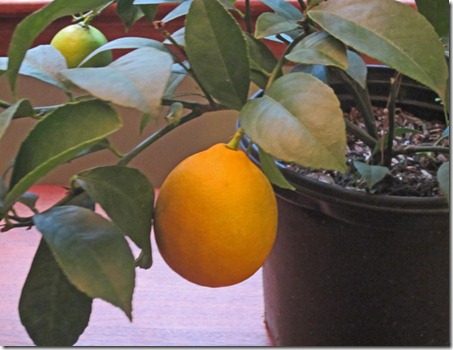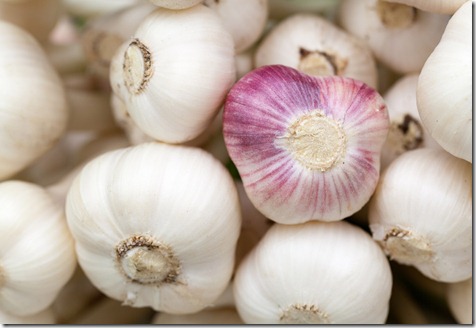
I added two 4x6 raised beds to the garden this spring, completing my phased implementation of my square foot garden. The extra beds gave me a lot of extra planting space and I kind of went overboard on some things. I wound up with an abundance of perishable items like lettuce and greens, more than our family could use and more than I could give away. I also had an overabundance of beans and squash.
This season, reading about everyone’s garlic and onion harvest, it occurred to me that maybe I should devote some of the garden space to crops that will store well into the winter without refrigeration and canning, rather than growing an overabundance of things I can’t use that will wind up in compost bins. So I decided to try growing onions, garlic and shallots.
Garlic and shallots are ideal for raised bed gardening since they like a fertile, well drained, loamy soil and Mel’s Mix should be ideal. In addition, they are shallow rooted, so the depth of raised beds should not be an issue. There are also opportunities for inter-planting. So for example, instead of allocating a few squares of my beds to quick growing radishes and turnips, I will instead plant them around the shallots and pull them before they interfere with shallot growth, freeing up those squares for something else.
Onions will be planted from plants next spring, but garlic and shallots have to be planted now. I ordered my garlic from Green Mountain Garlic, a small, organic grower in Waterbury, Vermont. I chose two hardneck varieties because they are very hardy and suited for Northeast conditions. German Extra Hardy is a so-called porcelain type with large bulbs containing an average of 6 cloves per bulb (24 cloves in a half pound). Bulbs have paper-white wrappers but the skin on the cloves has some reddish coloring. It is supposed to store well and has a mildly spicy flavor. The other variety I chose is Chesnok Red, a purple stripe variety from the former Russian Republic of Georgia. The bulbs and cloves were slightly smaller than the German Extra Hardy, yielding 45 cloves from a half pound.
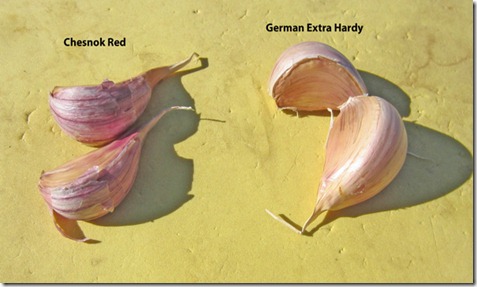
The beds were prepared by weeding them and adding a generous amount of compost, then marking the squares.
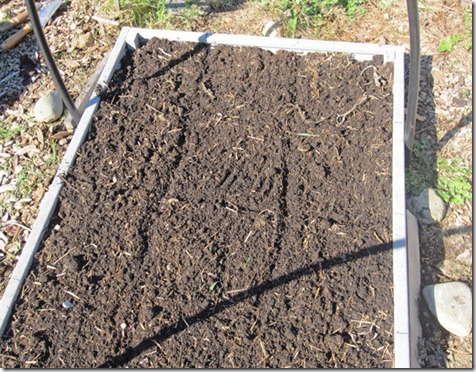
The Chesnok Red was planted 9 per square foot, the normal recommended spacing. Given the size of the German Extra Hardy bulbs, I planted it at 6 per square foot. Holes were made with a dibble and the cloves pushed down a couple of inches. The beds were then mulched lightly with chopped straw and watered. I had to get these in now because we are facing a lot of rainy weather in the next few days.

As a last minute decision, I also chose to try growing shallots. At 7-9 dollars per pound at the markets, shallots can theoretically yield a valuable crop, not to mention the enjoyment from having a nice stash of shallots to call on as needed. Of course, I was late in making this decision so many suppliers were sold out. I found Southern Exposure Seed Exchange in Virginia still has a good supply. I ordered the ones labeled “French Red Shallots” and as a plus, they are certified organic. The bulbs I received were very large, compound bulbs. You have to feel under the skin for seams indicating multiple bulbs and break them apart before planting. A pound yielded 21 good sized bulbs ready for planting.
Again, the beds were prepared with compost. Usual spacing is 4 per square foot. The bulbs are planted to a depth of about two thirds the length of the bulb, with the top third sticking out. Shallots do not like to be completely buried and may rot. I planted 4 per square in 5 squares, and selected the largest bulb I received to have its own square. Since they multiply at about a 4-6 ratio, 20 bulbs should give me 90-100 bulbs at harvest, or about 5 pounds of shallots. That’s the theory, we will have to see what actually happens.
.
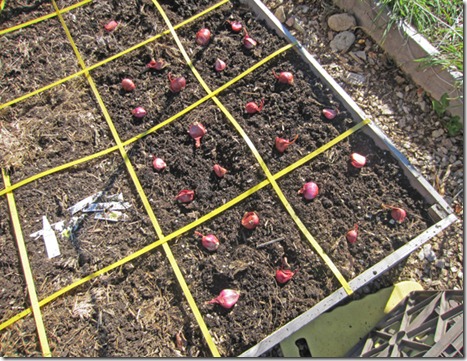
Here are some good links for information on growing garlic:
http://squarefoot.creatingforum.com/t10215-friday-rookie-topic-garlic
http://www.organicgardening.com/learn-and-grow/garlic-growing-guide
Braiding garlic video ( http://youtu.be/G7Xyj82oO4g )
Harvesting and curing video ( http://youtu.be/gpuU2qLuylU )
Links for growing shallots:
http://squarefoot.creatingforum.com/t7360-friday-s-rookie-topic-vi-shallots
http://www.vegetablegardener.com/item/5252/how-to-grow-shallots/page/all

